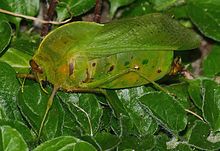Pneumoridae
| Pneumoridae | |
|---|---|

| |
| Bullacris intermedia | |
| Scientific classification | |
| Domain: | Eukaryota |
| Kingdom: | Animalia |
| Phylum: | Arthropoda |
| Class: | Insecta |
| Order: | Orthoptera |
| Suborder: | Caelifera |
| Infraorder: | Acrididea |
| Informal group: | Acridomorpha |
| Superfamily: | Pneumoroidea Blanchard,1845 |
| Family: | Pneumoridae Blanchard, 1845 |
| Genera | |
ThePneumoridaeare afamilyof nocturnal short-hornedgrasshoppersin the orderOrthoptera,commonly known as thebladder grasshoppersand the sole representative of the superfamilyPneumoroidea.[1]Theircentre of diversityis insouthern Africa,but one species occurs as far north asSouth Sudan.Most adult males acquire an inflated abdomen, a specialization for amplified sound production, which is likely its primary function. Most genera display strikingsexual dimorphism,[2]and several species exhibit a dual malephenotype.[3]
Description[edit]
They are nocturnal, specialized herbivores which (with few exceptions) are endemic to coastal regions ofsouthern Africa.[1]The smallest species isPneumoracris brownioccurring in theSucculent Karooecoregion, while the largest is the wide-rangingAfromontaneforest species,Physophorina livingstoni.
| lateral ocelli relative to antennal bases |
genus[2] |
|---|---|
| above and slightly internally | Bullacrisand related genera |
| intermediate position | Prostallia |
| above and slightly externally | PhysophorinaandPneumora |
Sexual dimorphism[edit]
The body length of adult males vary from 11.5 to 68.0 mm, and that of females from 22.0 to 107 mm. Males of a particular species may or may not have an inflated body with fully developed wings, or both morphs may be present. Males have large ocelli, a prominently crested pronotum, and are smaller in size. Females' bodies are larger and not inflated, and possess only reduced elytra and wings. Female ocelli are vestigial and the pronotum is more tectiform, while the sound-producing mechanism is entirely different.[2]
Males[edit]
Adult males of most species acquire an inflated, bladder-like abdomen at the final molt. Their abdominal segments consist of a thin, semitransparent integument, and are enlarged in length and width, while the intersegmental membranes are much reduced.[2]Males are capable of producing loud calls, a long and very deep rasping noise,[2]which members of their species can detect from 2 km away. Males call by stridulating the rasp on the inner surface of their rather weak hind femur against an opposing rasp on the third tergite of the inflated, hollow abdomen. These sclerotized abdominal ridges form a crescent-like row, and their exact number has some value in distinguishing between taxa.[2]In species without an inflated body, these characters are only vestigial. The wings of males have a primitive morphology, and are not suited to producing sound.[4]Their wing venation is in fact the simplest of all theAcridoidea.[2]
Females[edit]
Females reply by duetting.[1]They employ a different sound mechanism to produce a distinguishable call, sometimes described as a high squeak, and perhaps only partially audible to humans. This is perhaps produced by rubbing strong wing veinlets armed with strong teeth against the abdomen, which is facilitated or accompanied by raising the pronotum at a high angle.[2]
Ecology[edit]
Within one species, a primary (plesiomorph) and alternative (apomorph) male form with differing mating strategies can arise. Details of these morphs were the basis for the description of two subfamilies, namely Pneumorinae (Dirsh 1975) and Parabullacrinae (Dirsh 1975). Three groups are distinguishable on the basis of their ecology, namely a forest, marginal, and desert group, of which the forest species are the most primitive.[5]
Genera and species[edit]
List of genera and species:[1][6]
GenusBullacrisRoberts,1941[7]: 18
- B. boschimana(Péringuey)
- Range:Northern Cape
- B. discolor(Thunberg)
- Range:Western CapeandEastern Cape,Habitat: Fynbos
- Phenotype: Inflated and uninflated males
- B. intermedia(Péringuey)
- Range: Eastern Cape andKwaZulu-Natal
- B. membracoides(Walker)
- Range: Eastern Cape, KwaZulu-Natal andMalawi,Habitat: Savanna
- Phenotype: Inflated and uninflated males
- B. obliqua(Thunberg)
- Range: Western Cape, Habitat: Fynbos
- Phenotype: Inflated and uninflated males
- B. serrata(Thunberg)
- Range: Western Cape and Eastern Cape
- B. unicolor(Linnaeus)
- Range: Cape provinces, Habitat: Succulent Karoo
- Phenotype: Only inflated males
GenusParabullacrisDirsh, 1963
- P. vansoniDisrch
- Range: Northern Cape, Habitat: Succulent Karoo
- Phenotype: Only uninflated males
GenusPhysemacrisRoberts,1941[7]: 19
- P. papilosus(Fabricius)
- Range: Western Cape
- P. variolosus(Linnaeus)
- Range: Western Cape, Habitat: Fynbos
- Phenotype: Only inflated males
GenusParaphysemacrisDirsh, 1963
- P. spinosusDirsh
- Range: Cape provinces, Habitat: Fynbos
- Phenotype: Only uninflated males
GenusPeringueyiacrisDirsh, 1965
- P. namaqua(Péringuey)
- Range: Northern Cape, Habitat: Succulent Karoo
- Phenotype: Only inflated males
GenusPneumoracrisDirsh, 1963
- P. browniDirsh
- Range: Northern Cape, Habitat: Succulent Karoo
- Phenotype: Only uninflated males
GenusProstalliaBolivar, 1906
- P. granulata(Stål)
- Range: KwaZulu-Natal andMpumalanga
GenusPhysophorinaWestwood, 1874
- P. livingstoniWestwood
- Range: South Africa,Mozambique,Malawi,Tanzania,UgandaandSouth Sudan,Habitat: Forest
- Phenotype: Only inflated males
- P. miranda(Péringuey)
- Range: South Africa andTanzania,Habitat: Forest
- Phenotype: Only inflated males
GenusPneumoraThunberg, 1775
- P. inanis(Fabricius)
- Range: South Africa and Tanzania, Habitat: Forest
- Phenotype: Only inflated males
References[edit]
- ^abcdDonelson, Nathan C.; van Staaden, Moira J. (10 May 2005). "Alternate tactics in male bladder grasshoppers Bullacris membracioides (Orthoptera: Pneumoridae)".Behaviour.142(6): 761–778.CiteSeerX10.1.1.552.8161.doi:10.1163/1568539054729088.
- ^abcdefghDirsh, V. M. (1965)."Revision of the Family Pneumoridae (Orthoptera: Acridoidea)".Bulletin of the British Museum (Natural History) Entomology.15(10): 323–396.Retrieved10 January2017.
- ^Donelson, Nathan (December 2007)."Inter- and Intraspecific variation in the Superfamily Pneumoroidea".DPhil dissertation.OhioLink.Retrieved11 January2017.
- ^Smart, John (20 August 2009). "On the wing-venation ofPhysemacris variolosa(Linn.) (Insecta: Pneumoridae) ".Proceedings of the Zoological Society of London.123(1): 199–202.doi:10.1111/j.1096-3642.1953.tb00165.x.
- ^Bruton, Michael N.; Alexander, Anne J.; van Staaden, Moira (1989).Alternative Life-History Styles of Animals.Dordrecht: Springer Netherlands. pp. 261–276.ISBN9789400926059.
- ^van Staaden, Moira."Family: Pneumoridae".A Catalogue of South African Insects.Rhodes University.Retrieved9 January2017.
- ^abRoberts, Radclyffe (1941). "Nomenclature in the Orthoptera concerning Genotype Designations".Transactions of the American Entomological Society.67(1/2): 1–34.JSTOR25077470.
External links[edit]
 Media related toPneumoridaeat Wikimedia Commons
Media related toPneumoridaeat Wikimedia Commons Data related toPneumoridaeat Wikispecies
Data related toPneumoridaeat Wikispecies
